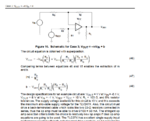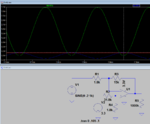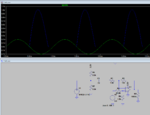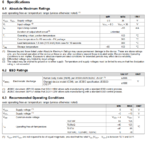pigtwo
Member level 4
Hello all,
I'm working on a small personal project where I want to take a signal from a microphone and do stuff with it. I'm trying to design a circuit to amplify the output from the microphone but I'm getting different results than I do from simulation. What I want to do is take a signal that can very from -200mV to 200mV and map this on to roughly 0V to 3.3V. I would like to do this without using a dual supply. I found this PDF from TI(https://www.ti.com/lit/an/sloa030a/sloa030a.pdf) that discusses this and gives a schematic that is what I need. Below is a screen shot of the schematic from the PDF.

I did the calculations and came to the circuit shown below. As you can see the simulation shows this working as expected.

But I've built the actual circuit and it doesn't behave like this. What I get is similar but the bias(the b value in the equation) is way to small. It is too small by a factor of roughly the gain of the amplifier. For example with the equations provided by TI I expect that if I input 0V to the amplifier I should get 1.65V out. But I don't get that. On the output of the OP amp I get the voltage on the non-inverting input. So noticing this I just use two 10k resistors as a divider to get 1.65V on the non-inverting input and now it works as I want.
So I have the circuit working as I want but one of the main reasons I do these projects is to try to learn so I'm trying to figure out why I'm getting different results. If it's important the op-amp I'm using is TLV2775CN. I choose this somewhat arbitrarily so maybe I missed something with it. Does anyone know what might be causing this? I can provide more picture if needed.
Thank you!
I'm working on a small personal project where I want to take a signal from a microphone and do stuff with it. I'm trying to design a circuit to amplify the output from the microphone but I'm getting different results than I do from simulation. What I want to do is take a signal that can very from -200mV to 200mV and map this on to roughly 0V to 3.3V. I would like to do this without using a dual supply. I found this PDF from TI(https://www.ti.com/lit/an/sloa030a/sloa030a.pdf) that discusses this and gives a schematic that is what I need. Below is a screen shot of the schematic from the PDF.

I did the calculations and came to the circuit shown below. As you can see the simulation shows this working as expected.

But I've built the actual circuit and it doesn't behave like this. What I get is similar but the bias(the b value in the equation) is way to small. It is too small by a factor of roughly the gain of the amplifier. For example with the equations provided by TI I expect that if I input 0V to the amplifier I should get 1.65V out. But I don't get that. On the output of the OP amp I get the voltage on the non-inverting input. So noticing this I just use two 10k resistors as a divider to get 1.65V on the non-inverting input and now it works as I want.
So I have the circuit working as I want but one of the main reasons I do these projects is to try to learn so I'm trying to figure out why I'm getting different results. If it's important the op-amp I'm using is TLV2775CN. I choose this somewhat arbitrarily so maybe I missed something with it. Does anyone know what might be causing this? I can provide more picture if needed.
Thank you!

